Gallery
- Flag of French Sudan
- Flag of Mali Federation (1959-1961)
The Kanaga mask is a mask of the Dogon of Mali traditionally used by members of the Awa Society, especially during the ceremonies of the cult of the dead (dama, ceremony of mourning).
The Kanaga mask evokes the Creator God Amma. It presents a double cross shape, which reminds the creation of the world, danced during funeral ceremonies where it is used by members of the Awa society. [1] The general uninitiated public tends to see there various animal subjects : the kommolo tebu (a bird), [2] the lizard, the iguana, the barâmkamza dullogu (a water insect), the hand of God or the female spirit of the trees (gyinu ya). [3] The mask is represented both in male and female form. The male version is the most numerous. [4]
Kanaga is represented on the flag of French Sudan (1892–1958) and the ephemeral Republic of Sudan (1958–1959). As well as that of the Federation of Mali (1959–1960) grouping Senegal and the Sudanese Republic.

The Dogon are an ethnic group indigenous to the central plateau region of Mali, in West Africa, south of the Niger bend, near the city of Bandiagara, and in Burkina Faso. The population numbers between 400,000 and 800,000. They speak the Dogon languages, which are considered to constitute an independent branch of the Niger–Congo language family, meaning that they are not closely related to any other languages.
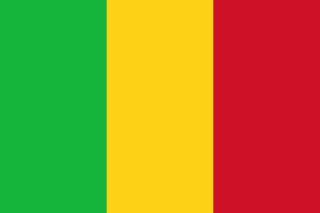
The national flag of Mali is a tricolour with three equal vertical stripes. From the hoist the colours are green, gold, and red, the pan-African colours. The flag of Mali is almost identical to the flag of Guinea, with the exception that the colours are in reverse order.

Mopti is a town and an urban commune in the Inner Niger Delta region of Mali. The town is the capital of the Mopti Cercle and the Mopti Region. Situated 630 km northeast of Bamako, the town lies at the confluence of the Niger and the Bani Rivers and is linked by an elevated causeway to the town of Sévaré. The urban commune, which includes both Mopti and Sévaré, had a population of 114,296 in the 2009 census.
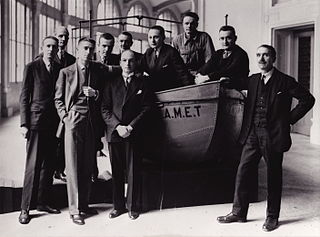
Marcel Griaule was a French author and anthropologist known for his studies of the Dogon people of West Africa, and for pioneering ethnographic field studies in France. He worked together with Germaine Dieterlen and Jean Rouch on African subjects. His publications number over 170 books and articles for scholarly journals.

Amadou Hampâté Bâ was a Malian writer, historian and ethnologist. He was an influential figure in twentieth-century African literature and cultural heritage. He was a champion of Africa's oral tradition and traditional knowledge and is remembered for the saying: "whenever an old man dies, it is as though a library were burning down."
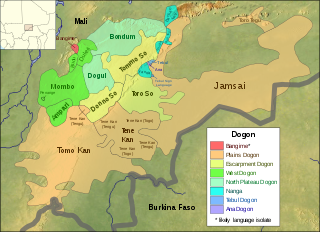
The Dogon languages are a small closely-related language family that is spoken by the Dogon people of Mali and may belong to the proposed Niger–Congo family. There are about 600,000 speakers of its dozen languages. They are tonal languages, and most, like Dogul, have two tones, but some, like Donno So, have three. Their basic word order is subject–object–verb.
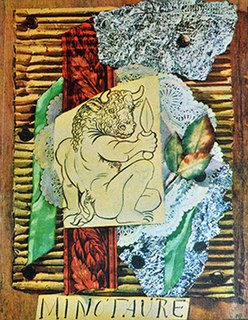
Minotaure was a Surrealist-oriented magazine founded by Albert Skira and E. Tériade in Paris and published between 1933 and 1939. Minotaure published on the plastic arts, poetry, and literature, avant garde, as well as articles on esoteric and unusual aspects of literary and art history. Also included were psychoanalytical studies and artistic aspects of anthropology and ethnography. It was a lavish and extravagant magazine by the standards of the 1930s, profusely illustrated with high quality reproductions of art, often in color.
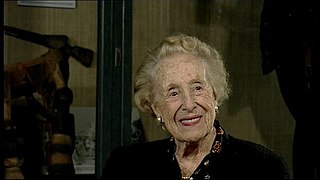
Germaine Dieterlen was a French anthropologist. She was a student of Marcel Mauss, worked with noted French anthropologists Marcel Griaule (1898-1956) and Jean Rouch, wrote on a large range of ethnographic topics and made pioneering contributions to the study of myths, initiations, techniques, graphic systems, objects, classifications, ritual and social structure.

The behaviour of snakes and their facial features seemed to imply that they were intelligent, that they lived by reason and not instinct, and yet their thought-processes were as alien to humans as their ways of movement.

Articles related to Mali include:
Les Ballets maliens is a Malian dance troupe created under the name 'Ensemble folklorique du Mali' in 1960, the day before the independence of Mali on September 22. By 1978, Les Ballets maliens had evolved into an artistic group specializing in traditional Malian dance, but open to the innovations of contemporary dance and choreography.
Sangha is a rural commune in the Cercle of Bandigara in the Mopti Region of Mali. The commune contains around 44 small villages and in the 2009 census had a population of 32,513. The administrative centre (chef-lieu) is the village of Sangha Ogol Leye, one of a cluster of at least 10 small villages at the top of the Bandiagara Escarpment.

Dogon country is a region of eastern Mali and northwestern Burkina Faso populated mainly by the Dogon people, a diverse ethnic group in West Africa with diverse languages. Like the term Serer country occupied by the Serer ethnic group, Dogon country is vast, and lies southwest of the Niger River belt. The region is composed of three zones: the plateau, the escarpment and the Seno-Gondo plain.
Deborah Lifchitz was a French Jewish expert on Semitic languages of Ethiopia, who worked at the Musée de l'Homme in Paris and took part in the Mission Dakar Djibouti in 1932-3. The Nazis imprisoned her in 1942; she was murdered in Auschwitz.

The flag of French Sudan was the French tricolour, used by most French colonial possessions, with a black stick figure with arms raised, a so-called kanaga. The flag continued to be used when the colony gained autonomy from France in 1958, but its colors were changed to green, yellow and red with the adoption of the flag of the independent Mali Federation in 1959.
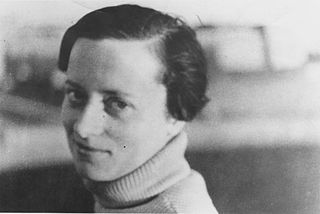
Denise Paulme (1909–1998) was a French Africanist and anthropologist. Her role in African literary studies, particularly in regards to the importance of Berber literature, was described as "pivotal".

Ogotemmeli was the Dogon elder and high priest (Hogon) who narrated the cosmogony, cosmology and symbols of the Dogon people to French anthropologist Marcel Griaule during the 1930s, 1940s, and 1950s, that went on to be documented and adapted by contemporary scholars. A lot of what is known about the Dogon religion, cosmogony and symbolism came from Griaule's work, which in turn came from Ogotemmeli—who taught it to him.
The Lebe or Lewe is a Dogon religious, secret institution and primordial ancestor, who arose from a serpent. According to Dogon cosmogony, Lebe is the reincarnation of the first Dogon ancestor who, resurrected in the form of a snake, guided the Dogons from the Mandé to the cliff of Bandiagara where they are found today.
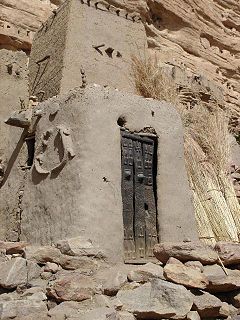
The Binou is a Dogon totemic, religious order and secret ceremonial practice which venerates the immortal ancestors. It can also mean a water serpent or protector of a family or clan in Dogon. It is one of the four tenets of Dogon religion—an African spirituality among the Dogon people of Mali. Although the Dogons' "Society of the Masks" is more well known, due in part to Dogon mask–dance culture which attracts huge tourism, it is only one aspect of Dogon religion, which apart from the worship of the Creator God Amma, a rather distant and abstract deity in the Dogon world-view, is above all made up of ancestor veneration. The Binou serves as one of the four aspects of Dogon religion's ancestor veneration. Other than the Binou and the worship of Amma, the other three aspects of the religion includes the veneration of Lebe, which pertains to an immortal ancestor (Lebe) who suffered a temporary death in Dogon primordial time but was resurrected by the Nommo; the veneration of souls; and lastly, the Society of the Masks, which relates to dead ancestors in general. These myths are in oral form—known to us in a secret language. They form the framework of Dogon's religious knowledge, and are the fixed Dogon's sources relating to the creation of the universe; the invention of fire, speech and culture.
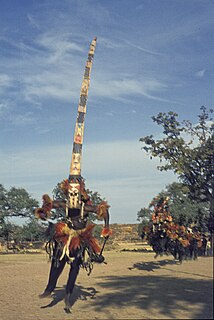
Awa, also known as the Awa Society, the Society of Masks, is an African mask and initiatory society of the Dogon people of Mali which is made up of circumcised men, and whose role is both ritual and political within Dogon society. The Awa Society takes an important role in Dogon religious affairs, and regularly preside over funereally rites and the dama ceremony—a ritual ceremony that marks the end of bereavement in Dogon country. This Society is one of the important aspect of Dogon religious life—which is primarily based on the worship of the single omnipotent, omniscient and omnipresent Creator God Amma and the veneration of the ancestors. Although it is only one aspect of Dogon's religious sects, it is perhaps more well known than the others partly due to Dogon mask–dance culture which attracts huge tourism, and their masks highly sought after, and in fact, one of the first to be sought after by art collectors in the west.